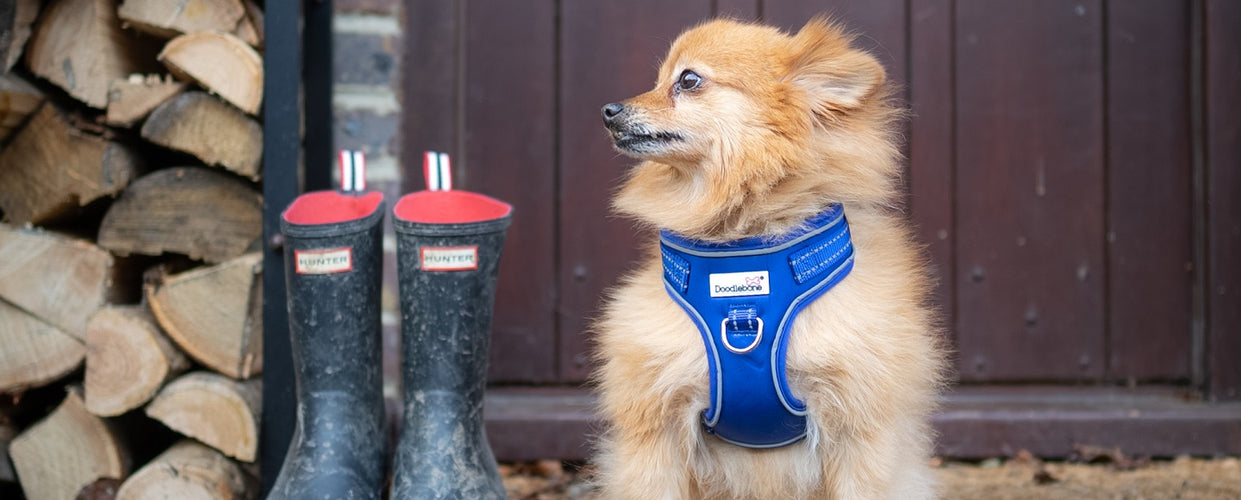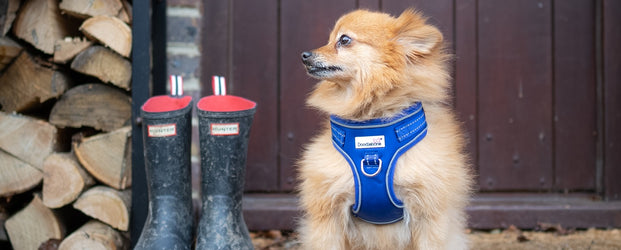

Posted by Emma Oldroyd, on
The Pets & Friends Guide to Dog Harnesses
Dog harnesses have become increasingly popular, not only as fashion statement, but they benefit both dogs and pet parents. Not only can they be more comfortable for dogs to wear whilst they walk, but using a harness and dog lead combination gives you as a pet parent better control of your dog.
Our experts have put together a guide to answer our most common questions about dog harnesses, including which type to pick and most importantly, how to measure your dog for their harness.
What are the reasons to use a dog harness?
The most common question we get, is “Does my dog need a harness?” and there are many reasons both you and your dog would benefit from using a harness during walks.
Lead pulling is one of the most common reasons people choose to use a dog harness rather than the usual dog collar and lead combination. Harnesses provide more control across their whole body rather than just the neck area, so you will find your dog will eventually pull less as pulling will become ineffective.
Harnesses are generally more comfortable for dogs, especially for brachycephalic dogs (dogs with short skulls and flat noses like Pugs and French bulldogs) Rather than all the pressure being around their neck, a harness ensures that pressure is evenly distributed across the top half of their body.
Harnesses can also be a more secure option for dogs who are always eager to escape. A harness is much more difficult to wriggle out of than a collar.

What kind of harness do you need for a dog?
The type of dog harness you choose for your pooch depends on your dog’s size, breed and walking type. Harnesses come in various shapes, sizes and designs which can suit different walking styles.
- A back clip harness like the BullyBillows Premium Comfort Harness is the most common type of dog harness on the market. The dog lead will attach at the back, giving you easy control as your dog walks. A back clip harness is best suited to dogs who don’t tend to pull during walks, or smaller breeds of dog.
- A front clip harness like the Halti Walking Harness has the lead attachment at the front, near your dog’s chest. These harnesses give you more control over your dog’s direction during a walk and are ideal for dogs who tend to pull or are prone to jumping. Front clip harnesses are also good for larger breeds of dog.
- ped into. These are great for dogs who react to having a harness popped over their head. However step-in harnesses are not always suitable for dogs whose neck and head are the same size.
- -Shaped harnesses offer more freedom of movement around your dog’s shoulders, these usually come with a back clip.
Each type of harness can come in a range of designs, including thicker straps which are helpful for larger dogs who may need extra support, harnesses with padded sections which can distribute pressure over a larger surface area , and mesh materials for a more breathable experience.
How to measure your dog for a harness.
You can measure your dog at home by using this step-by-step guide:
Always use a measuring tape with both CM and INCHES as different brands use different metrics in their size guides. It’s also a good idea to make sure your dog is standing still, so you may want to use some distraction tactics!
- Firstly, wrap the measuring tape around the widest section of their ribcage.
- Next, you’ll need to measure around your dog’s neck. The best way to do this is to measure around the base of your dog’s neck where their collar sits.
- For some harnesses or coats, it’s also useful to measure the length of your dog’s back too.
Before buying, always check your dog’s measurements against size guide provided. This is important, as sizes can vary depending on the manufacturer. If you’re not sure how your sizing measures up, try to go for a harness that has adjustable straps.
Always try your dog’s harness on to check before going out for a walk, the general rule is to ensure you can fit at least two fingers between the harness and your dog's body. If you can’t, it’s too tight. If you can fit more, it’s likely not tight enough.
Top tip: If your dog's neck size overlaps two sizes, then unless you expect your dog to continue growing, the smaller of the two sizes is probably the better choice for your dog.
If you’re not sure on how to get the perfect fit or need assistance measuring your dog- here at Pets & Friends, we offer a free harness measuring service in-store. Not only can we help measure your dog, but we can help recommend the most suitable harness and fit them whilst you wait. Simply pop into your local store and our colleagues can help, there’s no appointment needed.
How to put on your dog’s harness.
When their new harness arrives, it’s important to expose them to the harness, especially if they haven’t used one before.
Dog accessories experts Bully Billows suggest leaving the harness around the house in areas that your dog can see. That way, they’ll become familiar with what it looks like. Let them hear what the buckles or straps sound like when secured. Let them have a sniff etc.
Each type of harness will require a different fitting- for example step-in harnesses require your dog to put their legs through the front straps and physically step in to the harness.
Most front and back clip harnesses will fit over your dog’s head and require one leg to go through the harness. You can then clip it in place and adjust the straps accordingly.
Once their harness is in place, remember the ‘two finger’ rule to ensure it fits correctly, and you’re all set for an adventure!
If you’re looking for the perfect dog harness, you can explore the full range online including our bestselling brands Doodlebone, Ruffwear, Ancol and more.
Our pet experts are always on hand at your local store to help you choose the best harness for your dog too, simply pop in for a free in-store harness fitting. No appointment needed!
